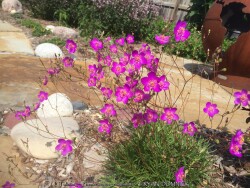

This tiny perennial wildflower (Talinum / Phemeranthus calycinum) produces ascending stems 2-6" long topped with bright magenta flowers. The cluster of bright green foliage at the base is only a few inches tall and resembles round tubes giving it a succulent look. Blooming occurs in mass, each flower lasting only 1 afternoon, but repeating all summer with available moisture. Fame Flower is native to a large area of the great plains to the eastern woods of Missouri and Arkansas. This cold hardy succulent occupies an unusual niche: growing in extremely shallow sandstone based soils and on sunny rock cliffs that dry out too quickly for most other plants to colonize. A good question is how does it find such isolated areas to colonize in the first place? Grow this small native gem in a rock garden, in cracks between rocks, or on top of or in a retaining wall. It will re-seed to thicken the colony but only germinate in bare thin soils with no mulch. It will not tolerate competition in rich moist soils as other plants will shade it out. If grown in pots and kept on the dry side, you may leave out all winter allowing to freeze solid; plants will either return from dormant stems or reseed in the same pot. Great low maintenance cold hardy succulent. ADDITIONAL INFORMATION ABOUT CREVICE GARDENING: In nature, some of the most interesting xeric plants grow in tough places such as inhospitable rock outcroppings with almost no soil. We can recreate that specific and exclusive growing environment with a crevice garden. Crevice gardening allows you to grow cold-hardy cacti and succulents that are normally cold hardy to our climate (Lawrence, KS zone 6a) but not normally tolerant of excessive moisture (40"/year), especially in the winter. This technique provides optimal xeriscape growing conditions by limiting the amount of soil and water around the roots and reducing the potential of root rot. Start with a raised mound of fast draining soil mix consisting mostly of decomposed granite, coarse sand, gravel, and a small amount of organic matter. Incorporate vertical rock formations such as flagstone into a raised landscape bed creating narrow 1-2" wide crevices filled with the soil mix. This helps quickly channel rain and snow melt water down more deeply into the soil encouraging deeper root growth while keeping the soil dry around the base of the plant. It is important that the entire mound is well above grade level to avoid drainage problems; crevice gardens typically range from 12"-36" tall. After installing the plants, mulch with a thin layer of pea-gravel or decomposed granite. In our Lawrence Kansas zone 6a winters with occasional polar vortexes or arctic blasts, this technique works well in any hot microclimate such as a south facing side of a berm or under a south or west facing roof overhand of a house or building. Kansas Plant Farm LLC built a trial crevice garden in 2022 and we have now had enough time to evaluate the plants after a true winter cold spell. During the arctic blast of January 2024, low nighttime temperatures got down to -11 degrees F (Jan 10th,2024). The longevity of this cold blast was also impressive: 4 days on a row with single digit highs including 1 day with a daytime negative high(-2F), 4 nights of lows in negatives (-8For lower), and 48 straight hours of 0 degrees F and mostly lower. A light snow cover helped insulate the ground but wind blew off most powdery snow on the foliage exposing the top parts of the plants to some extreme temperatures with surprisingly little damage. In our crevice trial gardens in Lawrence, KS (zone 6a), this variety survived harsh winters for 20 plus years.


This tiny perennial wildflower (Talinum / Phemeranthus calycinum) produces ascending stems 2-6" long topped with bright magenta flowers. The cluster of bright green foliage at the base is only a few inches tall and resembles round tubes giving it a succulent look. Blooming occurs in mass, each flower lasting only 1 afternoon, but repeating all summer with available moisture. Fame Flower is native to a large area of the great plains to the eastern woods of Missouri and Arkansas. This cold hardy succulent occupies an unusual niche: growing in extremely shallow sandstone based soils and on sunny rock cliffs that dry out too quickly for most other plants to colonize. A good question is how does it find such isolated areas to colonize in the first place? Grow this small native gem in a rock garden, in cracks between rocks, or on top of or in a retaining wall. It will re-seed to thicken the colony but only germinate in bare thin soils with no mulch. It will not tolerate competition in rich moist soils as other plants will shade it out. If grown in pots and kept on the dry side, you may leave out all winter allowing to freeze solid; plants will either return from dormant stems or reseed in the same pot. Great low maintenance cold hardy succulent. ADDITIONAL INFORMATION ABOUT CREVICE GARDENING: In nature, some of the most interesting xeric plants grow in tough places such as inhospitable rock outcroppings with almost no soil. We can recreate that specific and exclusive growing environment with a crevice garden. Crevice gardening allows you to grow cold-hardy cacti and succulents that are normally cold hardy to our climate (Lawrence, KS zone 6a) but not normally tolerant of excessive moisture (40"/year), especially in the winter. This technique provides optimal xeriscape growing conditions by limiting the amount of soil and water around the roots and reducing the potential of root rot. Start with a raised mound of fast draining soil mix consisting mostly of decomposed granite, coarse sand, gravel, and a small amount of organic matter. Incorporate vertical rock formations such as flagstone into a raised landscape bed creating narrow 1-2" wide crevices filled with the soil mix. This helps quickly channel rain and snow melt water down more deeply into the soil encouraging deeper root growth while keeping the soil dry around the base of the plant. It is important that the entire mound is well above grade level to avoid drainage problems; crevice gardens typically range from 12"-36" tall. After installing the plants, mulch with a thin layer of pea-gravel or decomposed granite. In our Lawrence Kansas zone 6a winters with occasional polar vortexes or arctic blasts, this technique works well in any hot microclimate such as a south facing side of a berm or under a south or west facing roof overhand of a house or building. Kansas Plant Farm LLC built a trial crevice garden in 2022 and we have now had enough time to evaluate the plants after a true winter cold spell. During the arctic blast of January 2024, low nighttime temperatures got down to -11 degrees F (Jan 10th,2024). The longevity of this cold blast was also impressive: 4 days on a row with single digit highs including 1 day with a daytime negative high(-2F), 4 nights of lows in negatives (-8For lower), and 48 straight hours of 0 degrees F and mostly lower. A light snow cover helped insulate the ground but wind blew off most powdery snow on the foliage exposing the top parts of the plants to some extreme temperatures with surprisingly little damage. In our crevice trial gardens in Lawrence, KS (zone 6a), this variety survived harsh winters for 20 plus years.


Bald Cypress (Taxodium distichum) is a well-known picturesque tree native to the southeast from Texas to Florida to Virginia. It is a deciduous conifer that grows on saturated and seasonally inundated soils but also performs well an average garden soils including some drought. Trees can be very long lived due to near immunity from pests and disease with some specimens over 2000 years old. When growing in standing water (exclusively), the characteristic knees develop. These are thought to assist an oxygen exchange or to trap sediment along a channel to stabilize the creek bank. Growth is slow during youth especially and dryer sites or poor soils but speeds up in rich well-drained soils. This non-flowering tree features extremely fine textured foliage that creates its own attractive mulch under the tree or blends in invisibly into the lawn. Most references indicate that acidic soil is important however I have seen these growing in pure white limestone alkaline streams in Austin Texas. The water was cyystal clear and pH was so high that not many other organisms for growing in it. Bald Cypress makes a beautiful street tree or residential landscape specimen that will be highly prized after a decade or two. Reserve for the wet test spot in your yard and it will thrive!
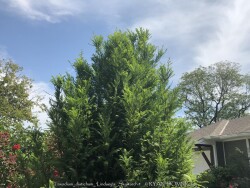

Bald Cypress (Taxodium distichum) is a well-known picturesque tree native to the southeast from Texas to Florida to Virginia. It is a deciduous conifer that grows on saturated and seasonally inundated soils but also performs well an average garden soils including some drought. Trees can be very long lived due to near immunity from pests and disease with some specimens over 2000 years old. When growing in standing water (exclusively), the characteristic knees develop. These are thought to assist an oxygen exchange or to trap sediment along a channel to stabilize the creek bank. Growth is slow during youth especially and dryer sites or poor soils but speeds up in rich well-drained soils. This non-flowering tree features extremely fine textured foliage that creates its own attractive mulch under the tree or blends in invisibly into the lawn. Most references indicate that acidic soil is important however I have seen these growing in pure white limestone alkaline streams in Austin Texas. The water was cyystal clear and pH was so high that not many other organisms for growing in it. Bald Cypress makes a beautiful street tree or residential landscape specimen that will be highly prized after a decade or two. Reserve for the wet test spot in your yard and it will thrive! Taxodium distichum 'Lindsey's Skyward' is a columnar upright form great for screening.
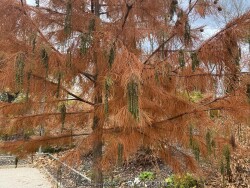

Bald Cypress (Taxodium distichum) is a well-known picturesque tree native to the southeast from Texas to Florida to Virginia. It is a deciduous conifer that grows on saturated and seasonally inundated soils but also performs well an average garden soils including some drought. Trees can be very long lived due to near immunity from pests and disease with some specimens over 2000 years old. When growing in standing water (exclusively), the characteristic knees develop. These are thought to assist an oxygen exchange or to trap sediment along a channel to stabilize the creek bank. Growth is slow during youth especially and dryer sites or poor soils but speeds up in rich well-drained soils. This non-flowering tree features extremely fine textured foliage that creates its own attractive mulch under the tree or blends in invisibly into the lawn. Most references indicate that acidic soil is important however I have seen these growing in pure white limestone alkaline streams in Austin Texas. The water was cyystal clear and pH was so high that not many other organisms for growing in it. Bald Cypress makes a beautiful street tree or residential landscape specimen that will be highly prized after a decade or two. Reserve for the wet test spot in your yard and it will thrive! Pond Cypress (Taxodium distichum var. imbricarium) in now considered a naturally occuring variety of Bald Cypress. Its old name was Taxodium ascendens. In comparison to Bald Cypress, Pond Cypress is somewhat smaller, more narrow, less branching and has very interesting scale-like spirally arranged leaves.
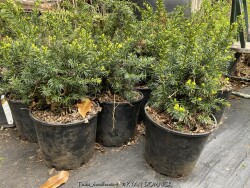

***Shrub descriptions available with future update!***Capitata Upright Pyramidal Yew, is also known as Taxus cuspidata 'Capitata'


Densiformis Hedge Yew (Taxus x media 'Densiformis') is an evergreen shrub with small flat needle-like dark green leaves. Small red "fruits" form on mature plants with proper pollination and in the absence of pruning. This yew is of hybrid origin along with many varieties ranging from small shrubs to small trees. Taxus x media varieties grow rather slowly and lend themself excellently to being pruned into hedges as long as not too much is taken off at one time. After a plant achieves a certain height, you may keep it that size indefinitely with 3 to 4 times per year pruning. Yews prefer part shade with rich to average well-drained soil and average moisture. Yews planted in the full sun will survive but develop an burnt yellowish green color when temperatures exceed 100°F. This is usually a problem in zone 6 or further south as there are many better choices for full sun (morning sun is okay). In zones 4-5, full sun is probably okay. Yews are best known for their tolerance to dry shade even under root bound conditions. They will not survive more than a couple years under a roof overhang due to lack of moisture in the winter and spider mite problems. In the Eastern and Southeastern United States, Yews have many problems including root rot, insect and disease issues. None of these are a problem in Kansas or Oklahoma with lower rainfall amounts and less humidity. In the landscape, yews offer a year-round structure. They definitely help provide a background for more interesting plants with colorful foliage and flowers. They are also very well known and used in formal garden designs. We prefer to see them less pruned and then there more natural state. A word of caution is that yews are poisonous.


Esperanza (Tecoma fulva) is an attractive, dry deciduous shrub native to southern Bolivia and northwestern Argentina with pinnate foliage and trumpet-shaped, bright orange-red flowers. Tecoma fulva 'Chicklet Orange' is a compact selection with exceptional flower power, so it will add a lot to landscapes either as a landscape shrub or as a patio plant. It has the same fun flowers as a trumpet vine but isn't invasive, and will grow 3-6' tall and 2-4' wide. It will do best in full sun. All Proven Winners® plants are legally propagated, healthy and vigorous, true to name, and tagged with color pictures and growing information.


Rice Paper Plant (Tetrapanax papyrifer) is a hardy tropical with large palmate leaves up to 24" across. In warmer zones and in its native habitat in Taiwan, Tetrapanax is a large shrub or small tree with white flowers produced in the fall. However in our Lawrence Kansas zone 6a climate, Tetrapanax is killed down to the ground each year like crapemyrtles and butterfly bush. A thick mulch is appreciated when young but not needed on established plantings. Tetrapanax is not picky about soils or moisture but will display fastest growth in rich, moist, well-drained areas in full sun. Tetrapanax will also tolerate almost full shade when established. Because it spreads by rhizomes, be sure to allow plenty of space or have control methods in place. Generally, chopping off shoots as they emerge as easy enough. Another word of caution is that Tetrapanax contains a white powdery-like cottony substance on near stems and back sides of leaves. This can cause eye and throat irritation so be careful when cutting back to not rub off the dust (or do so up-wind). Tetrapanax is a very rare plant in cultivation but can also be seen at the Wichita botanical gardens, Botanica. There is a giant form called Tetrapanax papyrifer 'Steroidal Giant' available at Plant Delights Nursery in North Carolina with leaves up to 3 feet wide and less spreading but we have not been able to procure or establish this plant in our Lawrence, KS garden. In our trial gardens in Lawrence, KS (zone 6a), three established mulched specimens of Tetrapanax papyrifer have survived for over 10 years including -17 degrees F in 2021. During that arctic blast of February, 2021, lows down to -17 degrees F on Feb 16th, 2021 were recorded. The longevity of this cold blast was also impressive: 10 days on a row with highs of 10-15 degrees F or lower, 8 nights of lows in the single digits and negatives, and 36 straight hours of 0 degrees F and mostly lower. It can also be grown as a potted patio plant; move into a cold garage or basement over the winter with minimal watering. Allow to go dormant as needed with little care, just cut off dead foliage and place back out in April or May with a time-release fertilizer.
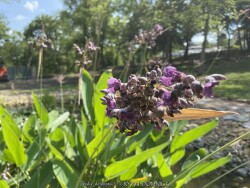

Thalia dealbata, commonly known as Hardy Water Canna, is a native water garden / marginal plant with tropical like foliage resembling that of a canna. This plant is usually grown as a bog plant needing constantly moist soil rich in organic matter. As a rain garden plant, it will thrive is a depressed area in the landscape that collects rain water from a roof during spring and summer periods of rain but then is amazingly drought tolerant if the water hole dries out. After extended drought, it will simply go dormant but not sure how long it will persist in this state. Flowers are purple and have been said to be carnivorous but in reality, small insects get trapped in the gummy gel-like substance around the flowers...larger polinators like bumble bees and carpenter bees can pull away after polination. There are no major or even minor pests: this plant will survive just about anything as long as the root ball doesn't freeze solid, hence the zone 6 designation by most sources. As far as winter hardiness, I would assume there is a requirement for being submerged in water or well mulched (or snow cover) if on dry land in sub freezing weather. A dry hard ground freeze can kill this plant even in warmer zones. In our Lawrence, Kansas display garden (zone 6a), this plant has thrived for many years with little effort.
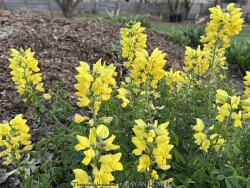

Yellow False Lupine / Lanceleaf Thermopsis, is also known as Thermopsis lanceolata. This plant has beautiful green narrow leaves and black stems on new emerging plants before flowering. Thermopsis lanceolata, the tapered false lupin, is a species of flowering plant in the legume family Fabaceae, native to Russia, Kazakhstan, Mongolia, Nepal and China.
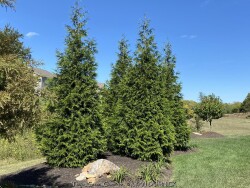

***Tree descriptions available with future update!*** Thuja 'Green Giant' is also known as Green Giant Arborvitae
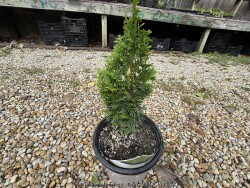

***Shrub descriptions available with future update!*** Thuja occidentalis 'Sting' is also known as Sting Columnar Arborvitae >>>>>>>>>>>>We love plants with interesting architecture, and this selection of our native Eastern arborvitae (Thuja occidentalis) takes skinny to the max with its sword-like sihouette. Use it to make an exclamation point in garden designs, or fit it into a very narrow bed. Certain to be iconic plant in well-designed landscapes everywhere
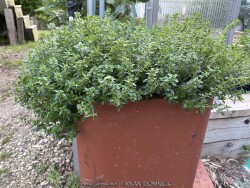

***Description for this perennial available with future update!***Mother of Thyme, is also known as Thymus serpyllum
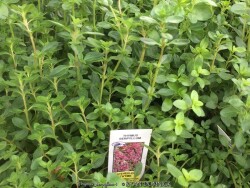

***Description for this perennial available with future update!***Red Creeping Thyme, is also known as Thymus serpyllum 'Coccineum'
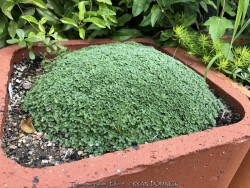

***Description for this perennial available with future update!***Elfin Miniature Creeping Thyme, is also known as Thymus serpyllum 'Elfin'
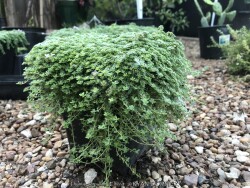

***Description for this perennial available with future update!***Elfin Miniature Creeping Thyme, is also known as Thymus serpyllum 'Elfin'
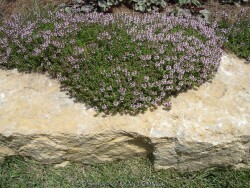

***Description for this perennial available with future update!***Pink Creeping Thyme, is also known as Thymus serpyllum 'Pink Chintz'
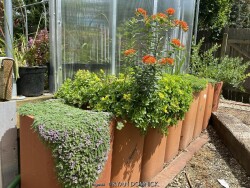

***Description for this perennial available with future update!***Creeping Thyme (Mixed Varieties), is also known as Thymus sp.
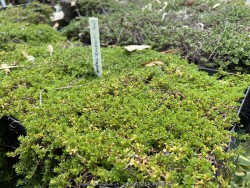

***Description for this perennial available with future update!***Creeping Thyme (Mixed Varieties) flat, is also known as Thymus sp.
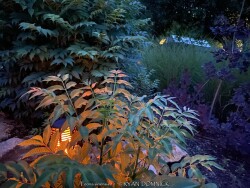

Chinese Toon (Toona sinensis) is a rare shrub-like tree from China in the mahogany family known for its edible leafy foliage. Foliage has an onion a flavor and can be eaten fresh or mixed into stir-fry vegetable recipes. When emerging in the spring, new foliage is a bright red to pink color and is enhanced by cooler weather in the spring. Bi-pinnate foliage deepens to a medium to dark green as it unfurls throughout the summer and has a strong resemblance in appearance to Tree of Heaven (Ailanthus altissima). Fall color is a gorgeous yellow lasting for a week or two. Chinese Toon is useful in the edible landscape as a "vegetable tree". Also very attractive in the landscape, it can form a background shrub, a specimen shrub, or a small colony. Grow in full sun and just about any well drained soil for best results. Although this grows into a "tree" in southern climates, it will typically freeze down to the ground each year in Lawrence Kansas. (zone 6a) The only maintenance is pruning winter-killed growth to the ground. New rapidly growing water sprout shoots will emerge by mid spring. New foliage is the most tasty to eat, so this works out great for harvesting when grown as a "vegetable tree". Chinese Toon can also be grown as a potted plant moved into a garage or dark basement: it doesn't seem to suffer from being root bound in a pot.


***Description for this plant available with future update!***Chinese Windmill Palm (Tropical), is also known as Trachycarpus fortunei


Sundew Oriental Borage / Black Sea Comfrey (Trachystemon orientalis 'Sundew') is a perennial with large textured bright chartreuse leaves with amazing contrasting light blue flowers. It is native from Bulgaria to the Caucasus and Turkey. This variety spreads very slowly by creeping rhizomes and forms an attractive groundcover. Foliage darkens slightly to green in summer and forms a quite dense and tight weed resistant covering. Comfrey prefers rich average to moist well-drained soils with part sun to full shade. However, being a tolerant plant, is very adaptable to both dry and moist locations and will grow quite nicely in dry shade. It is not particular as to soil type or pH. and is highly tolerant of urban pollution and will even thrive in inner city environments. There is virtually no maintenance unless you want to mow down the dead foliage in the winter. It is also suggested to deadhead the flowers after blooming as they are not attractive. But if you don't, they will die back on their own and get swallowed up by the foliage. There are no pest, disease, or browser problems. Considered one of the best plants for solving your most difficult dry-shade landscape challenges. Trachystemon orientalis 'Sundew' has persisted through over a decade in our Lawrence, KS display garden with no problems. Our original display garden plant came from Plant Delights Nursery in North Carolina.


***Description for this perennial available with future update!*** Tradescantia x andersoniana 'Amethyst Kiss' is also known as Amethyst Kiss Spiderwort.
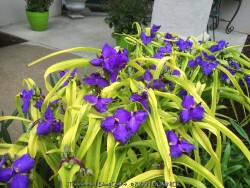

***Description for this perennial available with future update!***Blue & Gold Spiderwort, is also known as Tradescantia x andersoniana 'Blue and Gold'
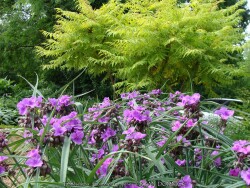

***Description for this perennial available with future update!***Concord Grape Spiderwort, is also known as Tradescantia x andersoniana 'Concord Grape'
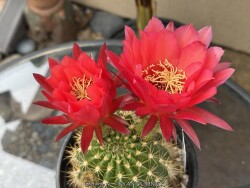

***Description for this plant available with future update!*** Trichocereus grandiflorus is also known as Torch Cactus (Tropical)>>>>> Cacti are known for their spines, unusual shapes and beautiful flowers. Both succulents and cacti store water in their fleshy tissues. And can survive long periods without water. Cacti and succulents are usually grown as a deck/patio plant or house plant in Kansas. Grow in full sun with little to no extra watering except that which comes from rainfall. Generally, plants may be brought out in Late May through Early October in our zone 6a Lawrence, KS climate. To play is safe, potted plants are best moved in before autumn leaves begin to drop and before night temperatures get below 45 degrees F. It is very important to avoid the combination of wet and cold. Move to a bright interior window over the winter with little to no watering and keep above 50 degrees F. As a winter house plant, it will look presentable all winter long with little to no waterings. As a permanent house plant, provide bright light and allow the soil to dry completely between waterings and you will get many years of carefree enjoyment. Plants grown permanently indoors may eventually begin to elongate stretching for light and lose their spine color. It can be hard to reproduce the intense UV sunlight they need when growing indoors so moving outside for the summer is best. Generally if moving outside for the summer, allow 1-2 weeks of part shade or morning sun before placing in full sun. Plants with time to acclimate will thrive in full sun but be careful not to rush it or sunburning may occur. Repotting may or may not be needed depending on how large you want the plant to grow; plants can continue to grow taller and tolerate extremely root-bound pots but may need wind bracing. If repotting, make sure to use a sharp draining low organic cactus mix with plenty of sand and perlite but avoid peat moss. The “soil” most commercial cacti are potted in to too peaty and light weight. This soil becomes hydrophobic and shrinks after becoming bone dry and difficult to re wet again. Cacti never grow in peat-based soils in nature; this “Soil” is only good for shipping because of the light weight. Potted plants are very low maintenance but watch for scale and mealybugs that may hide beneath the cover of spines. The best pest removal approach is to periodically wash the cactus off. Achieve this with a water nozzle or hose breaker turned mostly off to increase the pressure from the blast of water. This high-pressured water kills the pests without damaging the thick cactus skin. Here are some little-known or rare factoids about cacti: 1. The "spines" are actually modified leaves filled with sap at first, then quickly drying out to form the spines! 2. Many cacti have bright colored flowers that mainly attract bees, while some tubular flowering types attract hummingbirds and bats. 3. Late on the evolutionary timeline, cacti fossils are rare to non-existent. Cacti are native almost exclusively to the Americas, while succulents can include a much larger plant palette be from any dry area in the world. 4. Some cactus plants have been known to survive more than 2 years without water. 5. Some cacti first evolved in a dry climate that later became wetter again. For example: several jungle species live as epiphytes in trees to achieve the fast drainage they need.
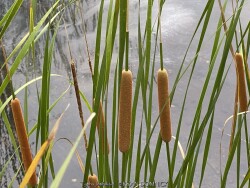

***Description for this water plant available with future update!*** Typha latifolia is also known as Broadleaf Cattail >>>>>>>>>>This plant is usually grown as a bog plant needing constantly moist soil rich in organic matter. As a rain garden plant, it will thrive is a depressed area in the landscape that collects rain water from a roof during spring and summer periods of rain but then go dormant if the water hole dries out completely. For the home garden, the species is generally too aggressive to mix with other plants